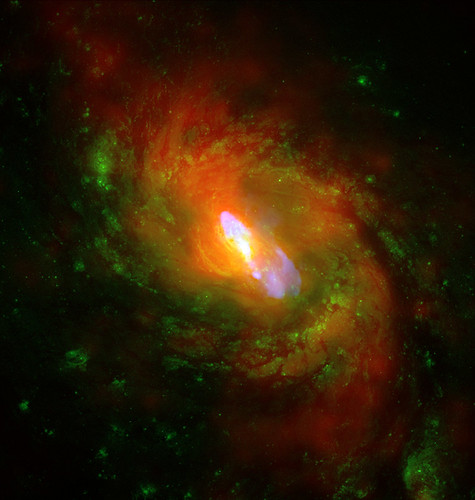Quick Insight of a Black Hole
A Close Observation of One of The Most Dangerous Objects in the Universe
Black Holes Explained - From Birth to Death

Source: NASA, Chandra, Hubble, 03/03/10
“Black Holes May Shape Galaxies (NASA, Chandra, Hubble, 03/03/10)” by NASA’s Marshall Space Flight Center is marked with CC BY-NC 2.0.
What is a black hole?
A black hole is a fallen star in a place where gravity is so strong that even light can not get out, because matter has been squeezed together. A black hole’s size can be either big or small, but according to scientists, the smallest black holes are as small as just one atom. Other types of black holes are “stellar” and “supermassive”. Small black holes form when the universe began. Stellar black holes are made when a big star collapse and causes a supernova. Supermassive black holes were created at the same time as the galaxy we are in.
Black holes are extremely dense, which means they have a strong gravitational attraction. The first image of a black hole was captured in 2019 by the Event Horizon Telescope collaboration. The Milky Way can potentially contain over 100 million of them.
We can’t see black holes, but the material around it is visible. When materials falls into a black hole, it will form a disc, but this depends on the kind of black hole. Hubble finds black holes through observations by collecting data they need to determine where these jets come from.

National Aeronautics and Space Administration Page Last Updated: Aug 21, 2018 NASA Official: Brian Dunbar
According to astronomers, the nearest black hole to Earth is just about 1,600 light years away. This black hole is 10 times as massive as the sun. The next nearest one known is about 3,000 light years away from Earth.
What happens if you decided to make a one-way trip to a black hole? As soon as you enter the event horizon, you’ll be spaghettified before you know it. Black holes are extremely dangerous-the intense amount of high-energy X-rays are hazardous for our health. Although scientists currently can’t observe black holes, we can, however, study and infer their presence by detecting the activity happening around them. In case you are wondering, there are about 100 billion supermassive black holes existing within our universe.
Related Stories
https://science.nasa.gov/astrophysics/focus-areas/black-holes
https://www.nationalgeographic.com/science/article/black-holes
https://www.space.com/15421-black-holes-facts-formation-discovery-sdcmp.html
https://hubblesite.org/contents/articles/black-holes.html
https://www.britannica.com/science/black-hole










